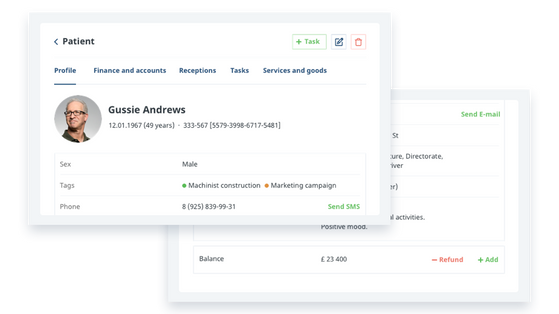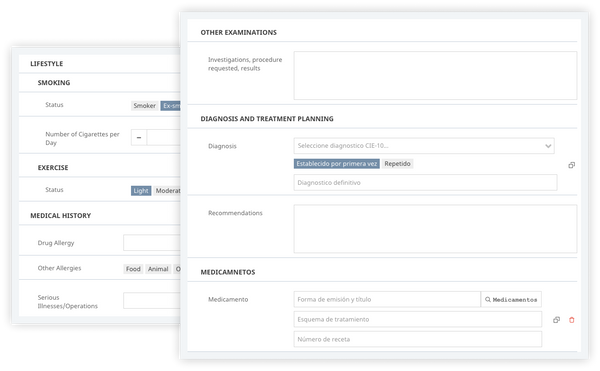Planning. Like it or not, it’s without a doubt a crucial part for effective mental health services.
If you have already successfully implemented a private practice business plan, your next step is to create reliable treatment plans and ways of tracking your patients’ progress.
That is because trackable patient progress is a keystone of your work, providing a fuller picture of a doctor-patient communication, patient’s well-being and highlighting its development and analysis.
Keep in mind that a good mental health professional works closely with every client, constructing individual treatment plans that lead to achievable goals and effective cognitive behavioral therapy.
Learn how to simplify your practice workflow and free up more time for patients with Medesk.
Open the detailed description >>In this article you will benefit from extensive information on creating reliable treatment plans and tracking patient progress, including:
- Why you need to track patient outcomes
- Monitoring a patient’s mental health progress
- Core elements of a treatment plan
And more!
Why do you need to track patient outcomes?
Every single person comes to a mental health provider with a problem and the only thing he is looking for is to recover.
Thus, his outcomes (in other words, recovery) is a final goal to be tracked, analyzed, and improved.
According to Donabedian model of evaluating quality of health care, outcomes and their tracking measures are the third element after structure and process. All three strong elements together represent so-called "the quality of care" you want to reach, no doubt here.
Essentially, tracking outcomes helps you to:
- Found out about the positive impact of treatment on every individual patient.
- Prevent the failure of psychotherapy, care, and reputation.
- Provide patients with the progress of their physical health "in figures" and facts.
- Increase knowledge of developments for patients, their family members, and practitioners to make care and treatment more adjustable and efficient.
Not to mention, patient satisfaction equals more new patients, investors, and better social media reputation.
Medesk helps automate scheduling and record-keeping, allowing you to recreate an individual approach to each patient, providing them with maximum attention.
Learn more >>Monitoring patient mental health progress: 5 tips to help you
At this very point, you know WHY it is vital to examine outcomes.
We should mention, there is no ideal model or set of measures for doing health records. Monitoring patient mental health success is to be tailored to the diagnosis, health status, types of services (online / offline) you provide, features and period of treatment.
Here are 5 common tips to help you track outcomes in mental health practice:
#1. Make a compilation of measures
First thing first is to understand what measures are appropriate and valid for assessing your practice or business.
Remember the ‘structure-process-outcome’ model to build your own measuring system.
For example, measures include:
- Questionnaires (existing data, therapy sessions)
- Biological metrics (EEG brainwave, hormones like cortisol)
- Diagnostic review (ICD-10)
#2. Use measures on a daily basis
Tracking progress should be an integral regular task of your personnel. Incorporate chosen measures into treatment plans, EHR, make them obligatory to implement daily, weekly, and monthly.
Discover more about the essential features of Medesk and claim your free access today!
Explore now >>Infrequent measurements result in lack of sufficient information about mental health conditions.
#3. Standardize your practice
Use medical practice management software (PMS) to standardize diagnoses and patient’s treatment, outcome measures, schedules, and due dates by adding this information to the EHR systems PMSs provide.
It is a great idea to keep all data about patients and their progress in one high quality mental health app.
#4. Establish confidential relationships with patients
It doesn’t matter if you are a private psychologist or you manage a mental health centre. The thing is: a patient must trust a doctor to get well.
Recent study states that ‘Routine Outcome Monitoring (ROM) is an important quality tool for measuring outcome of treatment in health care’.
For this reason, ROM is only effective when there is an interactive discussion between a mental health care professional and a patient.

Polite, attentive but fair psychologist is more likely to succeed if we talk about the recovery of a patient, e.g. from post-traumatic stress disorder.
#5. Make up detailed treatment plans
Treatment planning is a traditional purpose of diagnostics. The importance of a correct treatment plan is determined by the origin reason of a treatment – behavioral health.
Diligent treatment plan also contributes to the ethics of the relationship between the therapist or clinic and their potential clients. This quality of treatment is expressed in the rule "truth is better than lies". Based on a thorough assessment, you can tell the patient what he can count on, avoiding unrealistic promises and not misleading him.
Thus, thorough planning contributes to the tracking of patient progress and patient health.
Let’s consider the core elements that help to make up a decent treatment plan.
Core elements of a treatment plan
Modern medical platforms have all tools for automated treatment planning. They are called mental health treatment plan software and are widely used among practitioners.
Using this software, before collecting anamnesis, a doctor enters personal information, gender, age, place of residence and medical history of the patient. This is the preliminary step of every plan, leading to a mental health solution.

The next steps are:
The first step in preparing a treatment plan is to build a disease concept. The therapist tries to analyze dysfunctional reactions of the patient and build a hypothesis in psychiatry. In this way, he hopes to solve many problems immediately.
The second step is to set high-priority goals. Reaching these goals helps a therapist to monitor the treatment outcomes. Remember, each goal is set according to a shared vision of a patient and a doctor.
Examples of goals:
- Cope with negative emotions and anxiety disorders
- Build communication
- Express anger
- Overcome eating disorders and so on
The third step includes setting specific objectives. These are small parts that help a patient reach bigger goals and overcome mental disorder. They are easily measurable and lead a patient through all therapy.
Examples of objectives are:
- Start seeing people
- Relieve bipolar symptoms
- Make to-do lists
- Do emotions diary
Simply said, an objective is a specific way to reach a goal.
The next element is a timeline for treatment progress. This is the most vital part if we talk about tracking progress. Here a practitioner points out goals, objectives, and, what is more important, terms of fulfilling them.
Finally, the cost. This part is for private psychologists and managers of mental health practices. Generally, doctors don’t know the cost of a treatment, but for a successful primary care it is crucial to analyze these numbers.
So we can name it a part of a treatment plan too.
Mental health progress notes software
To standardize tracking and analyzing patient outcomes it is more preferable to use online platforms, mobile apps and PMS.
They simplify the process of creating and managing treatment plans allowing you to spend more time with patients. These platforms make it more efficient for clinicians to produce progress documentation and easier for administrators to study it.

The advantages of Medesk are psychometric score comparisons, that make tracking progress a gradual everyday option. You can compare the results of mental health problems curing over time for a fuller recovery picture. Also, Medesk allows you to monitor treatment types per patient, e.g. pharmaceutical, therapy, CBT, etc.
User-friendly format of PMS is used to create individual treatment plans for your patients and it makes it easier to track their progress.
The biggest advantage of such platforms consists of eliminating unnecessary parts of workflow. All changes are pulled automatically into treatment plans. Recommendations, analyses results and progress are available 24/7.
So, if you are looking for the best way to build trackable progress for mental patient care, we recommend you to choose a PMS.
Do not forget: proper documentation isn’t necessarily a dull, time-consuming and stressful process.


